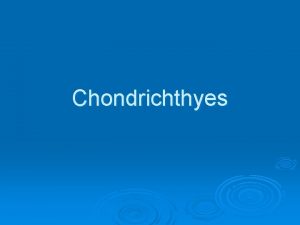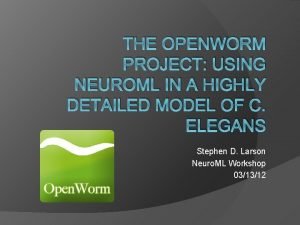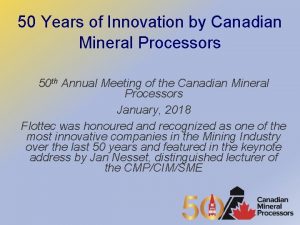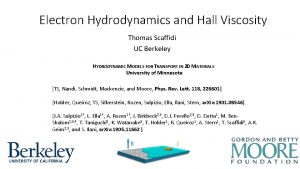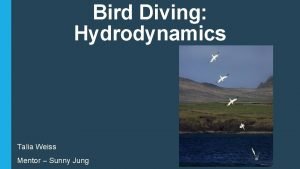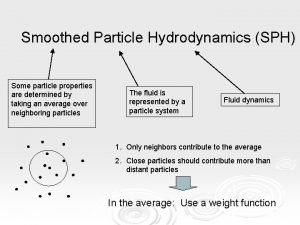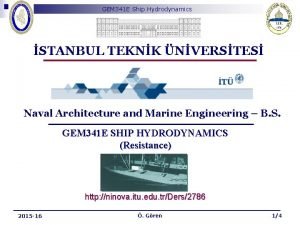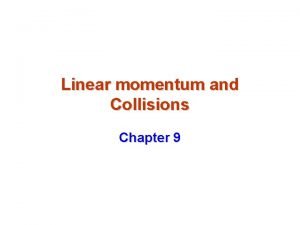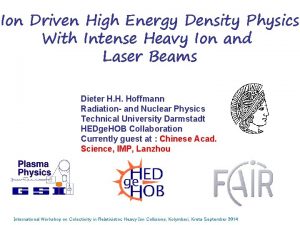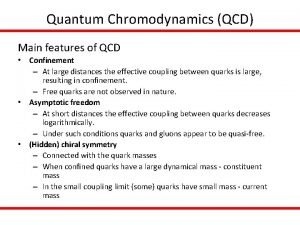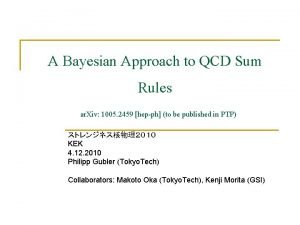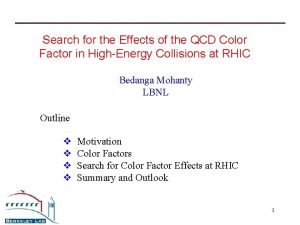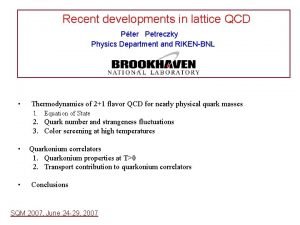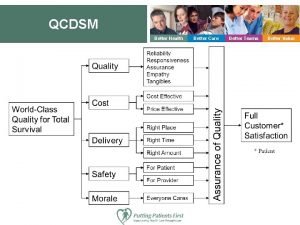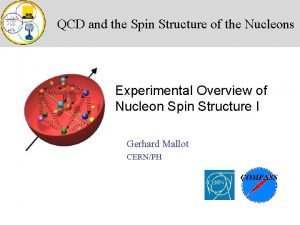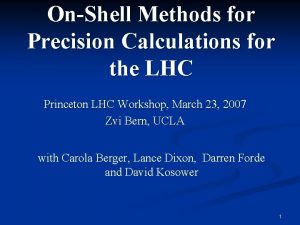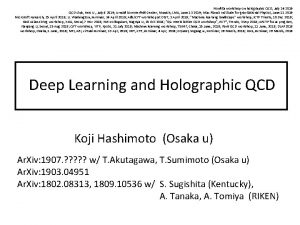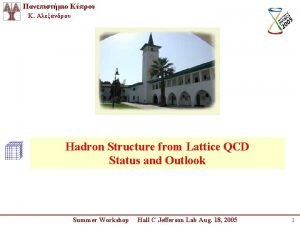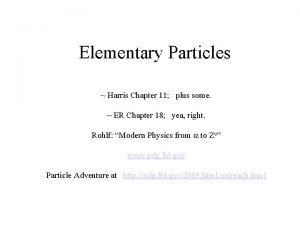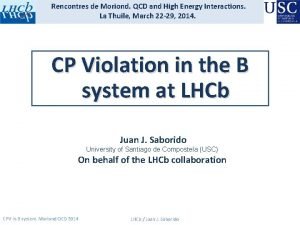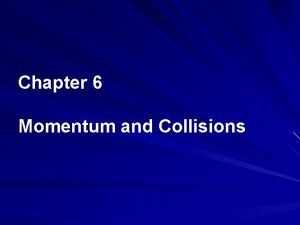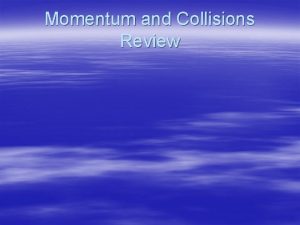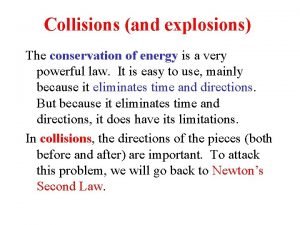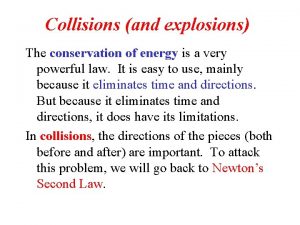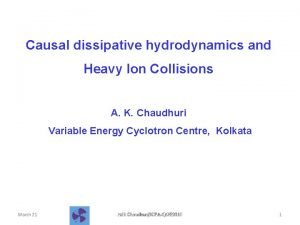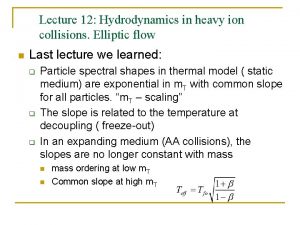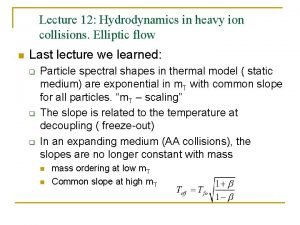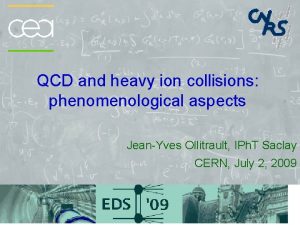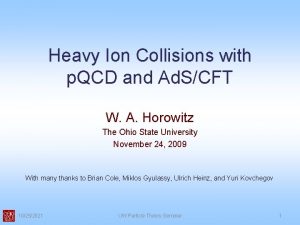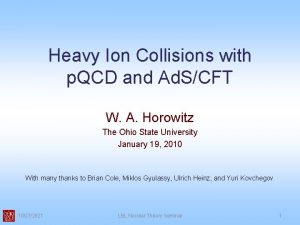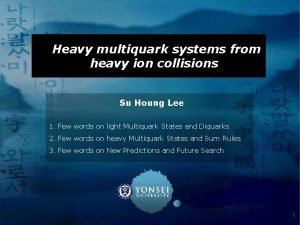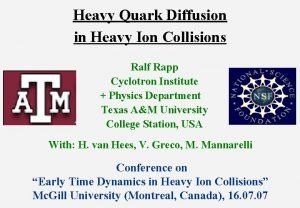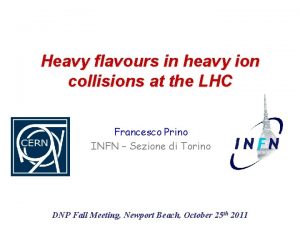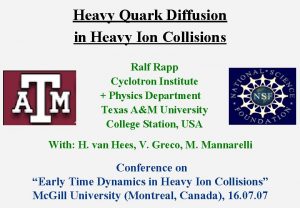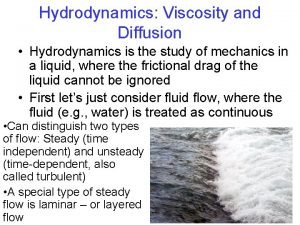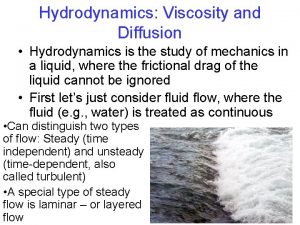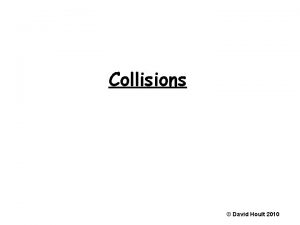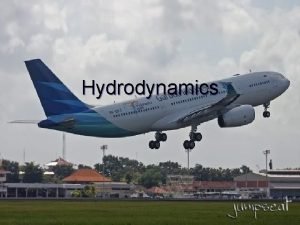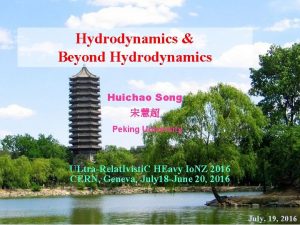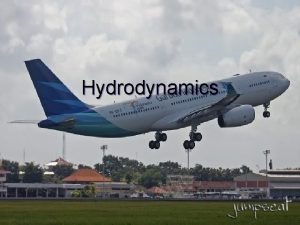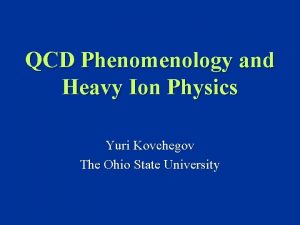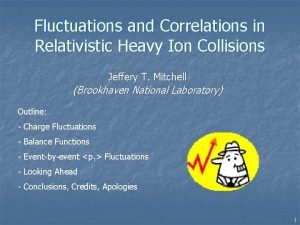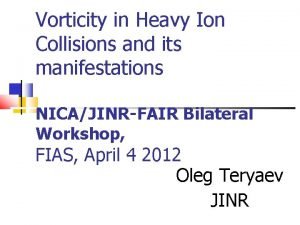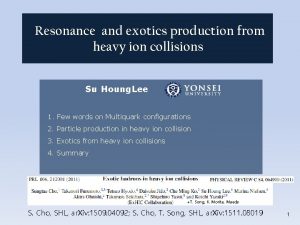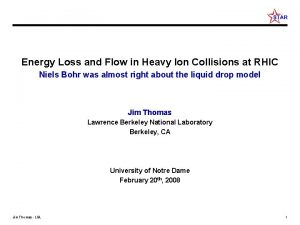Hydrodynamics in Heavy Ion Collisions and QCD Equation































- Slides: 31

Hydrodynamics in Heavy Ion Collisions and QCD Equation of State Current status of a 3 D hydro+cascade model Tetsufumi Hirano Department of Physics The University of Tokyo References: T. Hirano, U. W. Heinz, D. Khaezeev, R. Lacey, Y. Nara Phys. Lett. B 636, 299 (2006); J. Phys. G 34, S 879 (2007); ar. Xiv: 0710. 5795 [nucl-th] (Phys. Rev. C, in press. ). T. Hirano, U. Heinz, (work in progress).

A Remark at the Beginning Hydrodynamic Model ≠Hydrodynamics So far, discovery of the perfect fluid QGP has been made by one particular modeling of relativistic hydrodynamics. How robust/fragile is the discovery? See, Huovinen’s talk

Inputs for Hydrodynamic Simulations for Perfect Fluids Final stage: Free streaming particles Need decoupling prescription t z 0 Intermediate stage: Hydrodynamics can be valid as far as local thermalization is achieved. Need EOS P(e, n) Initial stage: Particle production, pre-thermalization? Instead, initial conditions for hydro simulations

time Our Strategy: QGP fluid + hadronic cascade in full 3 D space hadron gas QGP fluid collision axis 0 Au Au Initial condition : 1. Glauber model 2. CGC model QGP fluid: 3 D ideal hydrodynamics (Tc = 170 Me. V) 1. massless free u, d, s+g gas + bag const. 2. Soft Eo. S Hadronphase: 1. Tth=100 Me. V 2. Hadronic cascade (Tsw = 169 Me. V) Hybrid approaches: (1 D) Bass, Dumitru (2 D) Teaney, Lauret, Shuryak, (3 D) Nonaka, Bass, Hirano et al.

Two Hydro Initial Conditions Which Clear the “First Hurdle” Centrality dependence Rapidity dependence 1. Glauber model Npart: Ncoll = 85%: 15% 2. CGC model Matching I. C. via e(x, y, hs) Kharzeev, Levin, and Nardi Implemented in hydro by TH and Nara

QGP fluid+hadron gas with Glauber I. C. p. T Spectra for PID hadrons A hybrid model works well up to p. T~1. 5 Ge. V/c. Other components (reco/frag) would appear above.

QGP+hadron fluids with Glauber I. C. TH et al. (’ 06) Centrality Dependence of v 2 • v 2 data are hadronic cascade result (Courtesy of M. Isse) comparable with hydro results. • Hadronic cascade cannot reproduce data. • Note that, in v 2 data, there exists eccentricity fluctuation which is not considered in model calculations.

QGP+hadron fluids with Glauber I. C. Pseudorapidity Dependence of v 2 QGP+hadron QGP only h<0 h=0 h>0 • v 2 data are comparable with hydro results again around h=0 • Not a QGP gas s. QGP • Nevertheless, large discrepancy in forward/backward rapidity TH(’ 02); TH and K. Tsuda(’ 02); TH et al. (’ 06).

QGP fluid+hadron gas with Glauber I. C. Importance of Hadronic “Corona” QGP fluid+hadron gas QGP+hadron fluids QGP only T. Hirano et al. , Phys. Lett. B 636(2006)299. • Boltzmann Eq. for hadrons instead of hydrodynamics • Including effective viscosity through finite mean free path

QGP fluid+hadron gas with Glauber I. C. Differential v 2, centrality dependence 20 -30% Mass dependence is o. k. Note: First result was obtained by Teaney et al. T. Hirano et al. (’ 07) • Centrality dependence is ok • Large reduction from pure hydro in small multiplicity events

QGP fluid+hadron gas with Glauber I. C. Differential v 2 in Forward hybrid model AMPT Adopted from S. J. Sanders (BRAHMS) talk @ QM 2006

QGP fluid+hadron gas with Glauber I. C. Mass Ordering for v 2(p. T) Pion 20 -30% Proton Mass dependence is o. k. from hydro+cascade. Mass ordering comes from hadronic rescattering effect. Interplay btw. radial and elliptic flows.

QGP fluid+hadron gas with Glauber I. C. f-meson case Just after hadronization b=7. 2 fm Final results b=7. 2 fm T = Tsw = 169 Me. V in p. T < 1 Ge. V/c Violation of mass ordering for phi mesons! Clear signal of early decoupling! Caveat: Published PHENIX data obtained in p. T>~1 Ge. V/c for f mesons

QGP fluid+hadron gas with Glauber I. C. Centrality Dependence of Differential v 2 PHENIX Pions, Au. Au 200 Ge. V Thanks to M. Shimomura (Tsukuba)

QGP fluid+hadron gas with Glauber I. C. Hybrid Model at Work at sqrt(s. NN)=62. 4 Ge. V PHENIX Pions, Au. Au 62. 4 Ge. V Thanks to M. Shimomura (Tsukuba)

QGP fluid+hadron gas with Glauber I. C. Differential v 2 in Au+Au and Cu+Cu Collisions Au+Au Cu+Cu Same Npart, different eccentricity Au+Au Cu+Cu Same eccentricity, different Npart

QGP fluid+hadron gas with Glauber I. C. Distribution of the Last Interaction Point from Hydro + Cascade x-t x-y px ~ 0. 5 Ge. V/c for pions • Long tail (w decay? elastic scattering? ) • Positive x-t correlation Blink: Ideal Hydro, no resonance decays Kolb and Heinz (2003)

QGP fluid+hadron gas with Glauber I. C. 1 D (Angle-averaged) Source Function from Hydro + Cascade KT=PT/2 0. 2 < KT <0. 36 Ge. V/c 0. 48 < KT <0. 6 Ge. V/c • Broader than PHENIX data • Almost no KT dependence ? PHENIX data • Significant effects of hadronic rescatterings PHENIX, PRL 98, 132301(2007); ar. Xiv: 0712. 4372[nucl-ex]

Summary So Far • A hybrid approach (QGP fluid + hadronic cascade) initialized by Glauber model works quite well. • (KT dependence of source size? ) • So far, so good. • What happens if initial condition is changed?

Eccentricity from CGC Initial Condition y x Hirano et al. (’ 06). Kuhlman et al. (’ 06), Drescher et al. (’ 06). See also, Lappi, Venugopalan (’ 06) Drescher, Nara (’ 07)

QGP fluid+hadron gas with CGC I. C. v 2 Depends on Initialization TH et al. (’ 06) Glauber: ü Early thermalization ü Discovery of Perfect Fluid QGP CGC: ü No perfect fluid? ü Additional viscosity required in QGP? Important to understand initial conditions much better for making a conclusion Adil, Gyulassy, Hirano(’ 06)

QGP fluid+hadron gas with CGC I. C. Soft Eo. S or Viscosity? v 2 is sensitive to sound velocity. Soft Eo. S in the QGP phase leads to reasonable reproduction of v 2 Again, importance of understanding initial conditions. Imprement of Lattice Eo. S?

Summary and Outlook • Success and challenge of a hydro + cascade model – Glauber + hard QGP Eo. S + hadronic afterburner – CGC + soft QGP Eo. S + hadronic afterburner • Future studies Higher Tc, Tsw or Lattice Eo. S Fluctuation of initial geometry

Why they shift oppositely? protons v 2(p. T) pions <p. T> p. T must decrease with proper time v 2 for protons can be negative even in positive elliptic flow TH and M. Gyulassy, NPA 769, 71(06) P. Huovinen et al. , PLB 503, 58(01)

What happens to strangeness sector?

Distribution of Freeze-Out Time (no decay) b=2. 0 fm Early kinetic freezeout for multistrange hadrons: van Hecke, Sorge, Xu(’ 98) Phi can serve a direct information at the hadronization.

phi/p Ratio as a function of p. T • pp collisions • Pure hydro in AA collisions • Hydro + cascade in AA collisions Clear signal for early decoupling of phi mesons

Recent Results from Lattice 1 16 81 e (Ge. V/fm 3) Max e 0 ~ 45 Ge. V/fm 3 in hydro at RHIC Ave. e 0 ~ 13 Ge. V/fm 3 M. Cheng et al. , Phys. Rev. D 77, 014511 (2008).

Source Imaging Koonin-Pratt eq. (Koonin(’ 77), Pratt(’ 84)): Primed quantities in Pair Co-Moving System (PCMS) (P = 0) Source function and normalized emission rate Source Imaging: (Brown&Danielewicz (’ 97 -)) Inverse problem from C to D with a kernel K No more Gaussian parameterization!

Long Tail Attributable to w Decay ? b=5. 8 fm Plot: PHENIX Hist. : Hydro+cascade w/o w decay No! Switch off omega decay by hand in hadronic cascade Long tail is still seen. Soft elastic scattering of pions?

3 D Source Function from Hydro + Cascade side out long • Source function in PCMS • 1 fm-slice in each direction • 0. 2<KT<0. 4 Ge. V/c, |h| < 0. 35, p+-p+, p--p- pairs • Black: With rescattering, Red: Without rescattering • No longer Gaussian shape (Lines: Gaussian) • Significantly broadened by hadronic rescatterings
 Top heavy bottom heavy asymptotes
Top heavy bottom heavy asymptotes Body shape of shark
Body shape of shark Hydrodynamics
Hydrodynamics Frother hydrodynamics
Frother hydrodynamics Thomas scaffidi
Thomas scaffidi Hydrodynamics
Hydrodynamics Smoothed particle hydrodynamics
Smoothed particle hydrodynamics Teknk
Teknk Combined velocity after collision formula
Combined velocity after collision formula Heavy ion
Heavy ion Ion dipolo
Ion dipolo Dipolo dipolo inducido
Dipolo dipolo inducido Fuerzas dipolo dipolo ejemplos
Fuerzas dipolo dipolo ejemplos Example of ion-ion interaction
Example of ion-ion interaction Qcd confinement
Qcd confinement Qcd sum rules
Qcd sum rules Color factor qcd
Color factor qcd Qcd
Qcd Qzcdsam
Qzcdsam Qcd lagrangian
Qcd lagrangian Nucleon
Nucleon Qcd penrose
Qcd penrose Qcd
Qcd Qcd
Qcd Electroweak interaction
Electroweak interaction Moriond qcd
Moriond qcd Elastic collision vs inelastic
Elastic collision vs inelastic Types of collisions
Types of collisions A moderate force will break an egg
A moderate force will break an egg Perfectly inelastic collision
Perfectly inelastic collision Collisions and explosions
Collisions and explosions Collisions
Collisions

